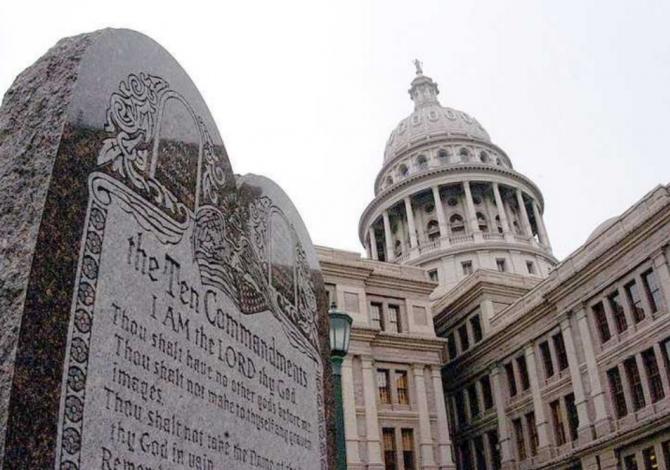When Texas Supreme Court Chief Justice Wallace Jefferson steps down on October 1, Texas will not only be losing a judicial leader, it will also be losing a champion for judicial reform. As chief justice, Jefferson spoke out forcefully for reforming the way Texas chooses its judges. Texas, like many other states, elects its judges.[1] This means that Texas’ judges, like its legislators and governors, must run for office as a member of a political party. It also means that these judicial candidates must fundraise in order to run a competitive campaign.
Texans expect judges to remain neutral referees that interpret the law and resolve disputes. But the judicial election system actually encourages the opposite: by requiring judicial candidates to fundraise, it can actually foster conflicts of interest. After all, the judicial election system both allows special interests to fund candidates and judges to rule on cases that may affect their campaign donors. A recent American Constitution Society study revealed that judges who have higher campaign contributions from business interests are more likely to rule for business litigants in court. Other studies have also concluded that campaign contributions and judicial rulings are correlated, including one that specifically examined the Texas Supreme Court.
The Texas legislature, to its credit, has attempted to mitigate some of these problems. In 1995, it passed the Judicial Campaign Fairness Act, limiting contributions to judicial candidates, among other things. But because the system itself is designed in a way that encourages conflicts of interest, anything short of systemic change will only have a marginal impact. Regulating campaign finance treats the symptoms, not the disease. Indeed, despite the Judicial Campaign Fairness Act, Supreme Court races remain expensive, with large donors funding their preferred candidates.
In the 2012 election, Supreme Court candidates raised more than $3 million. That election, Supreme Court Justice David Medina lost in an expensive primary to Tea Party challenger John Devine. Devine, an anti-abortion activist who, as a judge, refused to remove the Ten Commandments from his courtroom, pulled in a large portion of his funding from a group named Texans for Family Values.[3]
Fortunately, the path to judicial selection reform has already been paved in other states– and three broad principles stand out. First, either the legislative or the executive branch should appoint judges. Doing so will insulate judges from the pressures of political campaigning.
However, this alone would still leave judges vulnerable to political maneuvering by legislators or the governor. The second broad principle seeks to address this issue: the appointment process should be guided by laws requiring the appointer to consider potential candidates on the basis of merit. Half of all states currently use a merit plan of some kind.
Finally, the judicial selection process should be one of checks and balances. If the governor appoints judges, for instance, the legislature should approve them – and vice versa. The public should also still have the ability to hold their public officials accountable. Retention elections, in which residents vote on whether a judge should keep his position, are a good way of ensuring public accountability. Significantly, there does not appear to be any correlation between campaign contributions and judicial rulings in systems with retention elections.
Some opponents of appointive systems claim that holding elections (rather than retention elections) helps the public hold judges accountable and prevents the governor from consolidating power through judicial appointments. However, recent Texas history does not bear this out. For all intents and purposes, Texas currently has a de-facto gubernatorial appointment system, in which Texas Supreme Court justices retire before the next election and allow the governor to appoint a replacement, who then runs as an incumbent. Gov. Perry has appointed 11 of the last 15 Texas Supreme Court justices this way. So, Texas has the worst of both worlds: a system that allows the governor to appoint judges, but still forces them to fundraise and campaign.
Texas can do better. The justice system should be impartial, but forcing judges to become politicians opens them up to the pressure to rule a way that benefits their donors and provides donors with the opportunity to handpick their preferred judges. To remedy this, Texas should adopt an appointive system with ample checks and balances – the integrity of our court system depends on it.
—
[1] Texas originally allowed the governor to appoint judges. In 1850, it replaced this appointive system with one in which voters elected judges. This shift was part of a national movement known as ‘Jacksonian Democracy.’ The governor briefly regained the authority to appoint judges during post-Civil War Reconstruction. But once Reconstruction ended, Texans stripped the executive branch of this power again, and returned to a judicial election system.
[2] In 2012, the Center for American Progress released a report documenting specific cases in which the judicial election system might have affected a particular ruling’s outcome.
[3] Even though David Medina lost, he actually outspent John Devine. But Devine was still able to raise almost $274,000. Without significant help from large donors, it is doubtful he could have been a serious contender for the Texas Supreme Court.

